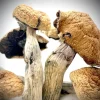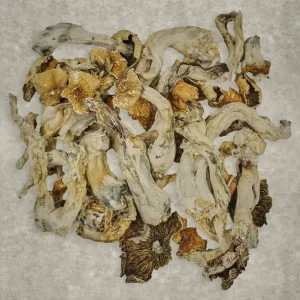Malabar mushroom
$120.00 – $230.00
Malabar Mushroom
The Malabar strain of magic mushrooms has a fascinating history that traces its origins back to India’s Malabar Coast region. Legend has it that locals stumbled upon this strain growing in elephant dung along the southwestern shore of the country. This unique method of cultivation, among others like using grain or agar, allowed the Malabar strain to grow abundantly with minimal intervention, producing high yields of these sought-after mushrooms.
Despite its incredible potential, the Malabar strain did not gain the same level of recognition and popularity in the Western world as other strains like the widely publicized Penis Envy. Instead, it quietly made its way across borders and established a dedicated following among users. However, it is important to note that in India, the Malabar strain held significant cultural and religious importance in the past. It played a central role in traditional practices and was a well-known name among many.
The story of Malabar Magic Mushrooms showcases their origins and impressive growth potential. While not widely recognized in Western nations, these mushrooms held significant value and played an important role in specific traditions in India. Studying various strains, including Malabar, provides valuable insights into the extensive history and varied applications of magic mushrooms globally.
Malabar Strain Origins
The Malabar strain of magic mushrooms is believed to have originated in India, specifically along the country’s southwestern shore known as the Malabar Coast. According to local rumors, the mushroom was discovered growing in elephant dung in this region, which eventually led to its name. The locals then began cultivating the strain using various methods such as feces, grain, or agar.
One notable characteristic of the Malabar strain is its ability to grow with minimal assistance while still yielding a high amount of mushrooms. This made it particularly desirable among cultivators and users alike. However, despite its prolific growth pattern and potential for cultivation, it did not gain immense popularity in the Western world.
It is interesting to note that despite being named after a specific region in India and having a history rooted there, the Malabar strain did not achieve widespread recognition outside of its origin. This suggests that other strains may have overshadowed its popularity or that it simply remained relatively unknown due to various factors. Nonetheless, the origins and unique characteristics of the Malabar strain contribute to the fascinating world of magic mushrooms and their cultural contexts.
History Of The Malabar Coast Mushroom
The Malabar coast mushroom has a fascinating history that dates back thousands of years. According to evidence, this magic mushroom strain can be traced as far back as 1500 BC in ancient India. It is interesting to note that the Malabar coast mushroom’s origins coincide with the period when the Vedas, a collection of religious scriptures, were written.
The Vedas are considered the oldest layer of Hinduism literature and provide insights into ancient Indian culture and spirituality. Within these sacred writings, there is mention of a spiritual substance called Soma. Many scholars believe that Soma was referring to the hallucinogenic properties of mushrooms like the Malabar strain. These texts describe Soma as a sacred drink consumed during rituals and ceremonies, believed to connect individuals with divine realms and enhance spiritual experiences. The role of Soma in these ancient practices suggests that magic mushrooms like the Malabar strain played a significant role in religious and spiritual traditions throughout history.
Potency & Psilocybin Content
When it comes to potency and psilocybin content, the variability among different strains of magic mushrooms is well-known. However, the strain in question has been rated as “above average” in terms of its potency. It has been found to contain between 0.90% and 1.80% total tryptamines, which is certainly on the higher end of the spectrum. This information was gathered from three samples that were entered into the Oakland Hyphae Psilocybin Cup, where it was discovered that this particular strain produces an average psychedelic tryptamine level of 0.90%.
Further analysis of one sample entered into the Spring 2021 Oakland Hyphae Psilocybin Cup revealed some specific levels of psilocybin and psilocin. This sample produced a psilocybin level of 0.90% and a psilocin level of 0.07%, resulting in a total tryptamine content of 1.14%. In terms of its potency, this strain is comparable to other well-known strains such as Chitwan, Amazonian, and Melmac.
Malabar Strain Characteristics
The Malabar strain of magic mushrooms is highly regarded among psychonauts and mycologists as the perfect choice for those looking to explore the world of psychedelic experiences. Its reputation stems from its unique combination of potency, visual effects, and overall positive experience it provides.
One of the most notable characteristics of the Malabar strain is its potency. This particular strain contains high levels of psilocin and psilocybin, the primary psychoactive compounds responsible for the hallucinogenic effects of magic mushrooms. As a result, users can expect a more intense and profound experience compared to other strains. However, what sets the Malabar strain apart is its ability to offer these powerful effects without overwhelming or disorienting individuals new to psychedelics.
The Malabar strain has visually stunning effects. Users often see vivid and intricate visuals during their trips. These visuals can range from colorful geometric patterns to surreal distortions. People find these hallucinations therapeutic or enlightening. The strain also creates a euphoric and uplifting mood enhancement. It is an immersive and enjoyable journey into altered states of consciousness.
Fruiting Body Appearance
The physical characteristics of the Malabar coast mushroom of magic mushrooms are reminiscent of what one would expect from a classic mushroom. These fungi have large fruiting bodies, with thick and fleshy stems that provide stability and support. The caps, although relatively small in comparison to the stem, still measure an average diameter of 2-3 inches. They are curved and display a yellowish-brown coloration, which intensifies toward the center as they mature.
One unique feature of the Malabar strain is the presence of a web-like veil that covers the underside of the cap when it is young. This veil acts as a protective covering for the developing gills but disappears once the body dries out. Speaking of gills, these magic mushrooms start with gray-colored gills but gradually darken to black as they age. This transformation in color is not only visually intriguing but also serves as an indicator of maturity for experienced collectors.
Spore Characteristics
The spore characteristics of the Malabar strain of Psilocybe cubensis make it a desirable choice for microscopists. With moderate spore quantities, it is relatively accessible for studying under a microscope. The spores themselves follow the usual pattern for this mushroom species, being purplish brown in color and oval in shape. These characteristics are typical of reproductive functions in mushrooms.
Additionally, the spore prints of the Malabar strain exhibit typical features of mushrooms containing psilocybin. They are dark in color and display concentric patterns evenly distributed on the surface of the print. These characteristics make it a suitable subject for research by amateur mycologists interested in studying the distinct properties of psilocybin mushrooms.
| Quantity | 1 Oz, 2 Oz |
|---|
6 reviews for Malabar mushroom
Only logged in customers who have purchased this product may leave a review.
Related products
Magic Mushroom Gummies
Magic Mushroom Gummies
Magic Mushroom Gummies
Magic Mushroom Gummies
Magic Mushroom Gummies
Magic Mushroom Gummies
Magic Mushroom Gummies
Magic Mushroom Gummies












Sadye (verified owner) –
Impressed with the intensity of the visuals and overall experience. Just be prepared for a long duration trip.
Cade (verified owner) –
Had a fantastic trip with these mushrooms, but the packaging could be more discreet.
Emerald (verified owner) –
These mushrooms were alright; the trip was decent but nothing amazing. I’ve had more memorable experiences with other strains.
Kirk (verified owner) –
Had a fun and enlightening journey with these mushrooms, but they were a bit dry.
Marianne (verified owner) –
These mushrooms were alright; the trip was decent but nothing extraordinary. I’ve had more profound experiences with different varieties.
Florence (verified owner) –
Prepare to be transported to realms beyond imagination with these mushrooms. A journey of self-discovery and spiritual awakening awaits.